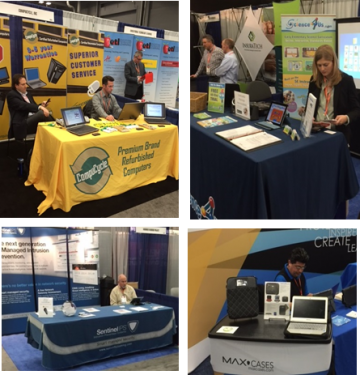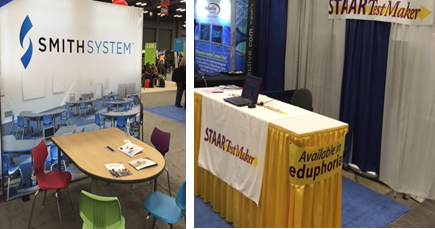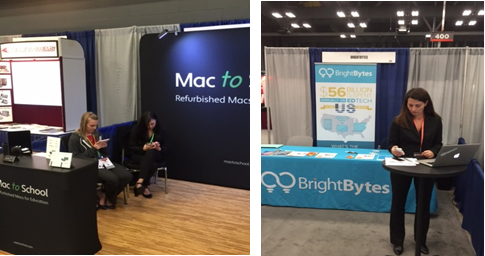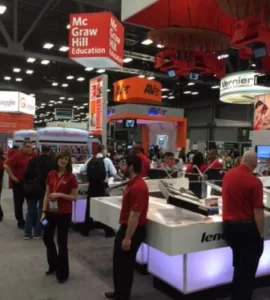Insights in Education
This is another installment in my new series that shines some light on the thinking, preferences and tendencies of your education market customers. I know them well. I was one of them. I’ve been an educational technology director for 25 years, with a significant track record in large educational technology purchases for schools. I managed budgets with millions of dollars over my twenty-six year career. Wouldn’t you like, for just a brief moment, to get inside my head? Maybe it will help you with your next exhibit hall presence. Here goes.
In my last article, Insight Series: What Sparks the Big Buy in Education, I talked about the spark – the kindling – that ignites action leading to large purchases by educators. In this article, I focus on what the educational customer really ‘sees’ in the grand exhibit halls at ed-tech conferences. We focus on some of the positive and negative messages that come across – including some surprising new occurrences on the venerated exhibit hall floor.
Positive Messages in the Exhibit Hall
Seating. Customer seating is never adequate in ed-tech exhibit halls, chiefly due to the high cost of space, but a new type of seating has proven particularly popular with educators at recent conferences: Bar-style seating appears attractive, welcoming and comfortable, while not encouraging customers to stay too long.
 Very popular bar-style seating at recent conferences.
Very popular bar-style seating at recent conferences.
Pullers. Some technology companies always seem to corral customer traffic more reliably. I noticed that each of these high-traffic booths used pullers—crowd gatherers—that go into the aisles and tease, cajole, or pull passers-by into their seated presentations or standing displays. That still works exceptionally well. And it is the exact opposite of the unwelcome trend for exhibitors to pull inside and away from the customer.
A ‘puller’ in action. But can you see what’s wrong with this picture?
Negative Messages in the Exhibit Hall
For educational customers, there are plenty of negative messages in exhibit halls these days. Most of these negative messages have to do with “not being present” for your customers. We as educators see these postures right away—and we don’t like them. Here are some of the most problematic examples, each occurring during moments when aisle traffic was actually quite busy:
Office-on-the-go. One problem I notices at recent conferences involved the number of company reps that were working, even during semi-busy times of the day. Perhaps these folks had too much to do, an overwhelming workload. Well, keep doing this and your workload will definitely soften, because we (your educational customers) won’t bother with you.
 Lots to do, apparently.
Lots to do, apparently.
Talky Talky. Another common problem we see in exhibit halls are sales reps that are more interested in talking with each other than attracting interested customers. Keep talking. We educators hate to interrupt. We’ll just pass you by. Nice to not meet you.
Talky Talky
Empty Promises. The ultimate experience for not being present is the “no one home” phenomenon. Perhaps you brought too few helpers. Perhaps you needed to visit the loo or grab a quick lunch. Face it. It’s hard to do business with educators like me with this approach.
 Knock, knock! No one home!
Knock, knock! No one home!
Cell-phone Addiction. The newest and single most common approach for “not being present” for customers, however, is that blasted cell phone. (Full disclosure: I own a brand new iPhone 6+, fully rigged.) It was surprising to see how large a phenomenon this has become, and how destructive it is to customer engagement. It was particularly addictive for younger sales reps, our hyper-connected millennials. These folks sent the worst possible message to educational customers: “We don’t care about you, so please don’t bother us until we put our phone down.” I interviewed many reps on the floor, who suggested they were guilty, but had to do it. They simply had so much to do. I heard plenty of excuses. Still, they are not present for the customer. Deeply disconnected. This is simply the biggest problem at ed-tech conferences today. Take a look for yourself.
 I think eye contact matters at conference exhibits. Do you?
I think eye contact matters at conference exhibits. Do you?
Overboard. Educators are a jittery bunch. We are easily spooked. Some booths have so many reps on staff, they greatly outnumber the customers at any given time. Take a look at this booth at TCEA:
It’s the red invasion!
Over-staffing your sales team at exhibit events isn’t natural. It’s like lions outnumbering the gazelles on the African savannah. That intimidates educators. It also sends the message that you don’t run a lean organization, so your product probably costs too much. Warning! Walk away!
Some Concluding Thoughts
It doesn’t have to be this way. In working several booths for large companies as the educator-on-call, I have never done these things while working a booth. I pay attention first and foremost to the customer. Sometimes I assist with customer connections at dinner meetings for various companies, yet I never take out my cell phone. I try to be fully present. Without a doubt, most of these postures simply show disrespect. As educators, we read that, and we respond accordingly. Be present, please. Len Scrogan.

